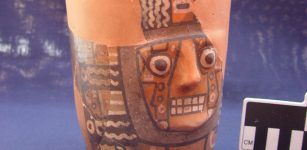New Details On Discovery Of San Jose 300-Year-Old Shipwreck That Sank With Treasure Of Gold, Silver, And Emeralds
AncientPages.com - New details from the successful search for the three-century old San José ship, called the “holy grail of shipwrecks,” have been released by WHOI (the Woods Hole Oceanographic Institution.
"We've been holding this under wraps out of respect for the Colombian government," said Rob Munier, WHOI's vice president for marine facilities and operations.
In November 2015, the MAC survey team and WHOI researchers returned to Colombian waters for a second search effort. Side scan sonar images gave the crew the first indications of the find from of the wreck. To confirm the wreck’s identity, REMUS descended to just 30 feet above the wreck where it was able to capture photos of a key distinguishing feature of the San José—its cannons. (REMUS image, Woods Hole Oceanographic Institution)
The exact location of the wreck of the San Jose, often called the "holy grail of shipwrecks," was considered one of history's enduring maritime mysteries.
The ship - a 62-gun, three-masted Spanish galleon ship that sank with a cargo believed to be worth billions of dollars - went down with a treasure of gold, silver, and emeralds in 1708.
The incident took place during a battle with British ships in the War of Spanish Succession.
The legendary wreck was discovered off the coast of Cartagena, Colombia, on Nov. 27, 2015, by a team of international scientists and engineers during an expedition aboard the Colombian Navy research ship ARC Malpelo led by MAC’s Chief Project Archaeologist Roger Dooley. It was found more than 600 meters below the surface during a search initiated by MAC and approved by The Colombian Ministry of Culture.
Ceramic jars and other items from the 300-year-old shipwreck of the Spanish galleon San Jose on the floor of the Caribbean Sea off the coast of Colombia. Image credit: ceramic jars and other items from the 300-year-old shipwreck of the Spanish galleon San Jose on the floor of the Caribbean Sea off the coast of Colombia.
Image credit: Woods Hole Oceanographic Institution via AP
WHOI played a crucial role in both the search and discovery of the final resting place of the San José, and an autonomous underwater vehicle called REMUS 6000 to survey an area off Colombia’s Barú Peninsula.
“The REMUS 6000 was the ideal tool for the job, since it’s capable of conducting long-duration missions over wide areas,” said WHOI engineer and expedition leader Mike Purcell.
REMUS was initially deployed off the Malpelo to survey an approved area in June 2015 but shipwreck was not found. In November, the expedition returned to the area.
“During that November expedition, we got the first indications of the find from side scan sonar images of the wreck,” said Purcell. “From those images, we could see strong sonar signal returns, so we sent REMUS back down for a closer look to collect camera images.”
To confirm the wreck’s identity, REMUS descended to just 30 feet above the wreck where it was able to capture photos of a key distinguishing feature of the San José—its cannons. Subsequent missions at lower altitudes showed engraved dolphins on the unique bronze cannons.
“The wreck was partially sediment-covered, but with the camera images from the lower altitude missions, we were able to see new details in the wreckage and the resolution was good enough to make out the decorative carving on the cannons,” said Purcell. “MAC’s lead marine archaeologist, Roger Dooley, interpreted the images and confirmed that the San José had finally been found.”
AncientPages.com























